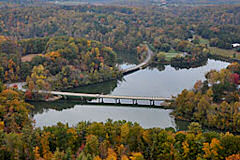 The Environmental Protection Agency (EPA) isn’t the only federal agency that would like to see a comprehensive environmental reevaluation of the Charlottesville Bypass. The Army Corps of Engineers contends that previous environmental studies, conducted in 1990 and 2002, may be outdated and do not fully explore alternatives to the bypass.
The Environmental Protection Agency (EPA) isn’t the only federal agency that would like to see a comprehensive environmental reevaluation of the Charlottesville Bypass. The Army Corps of Engineers contends that previous environmental studies, conducted in 1990 and 2002, may be outdated and do not fully explore alternatives to the bypass.
The Norfolk District of the Army Corps claims jurisdiction over 2.8 acres of wetlands and 7,040 linear feet of streams impacted by the proposed U.S. 29 bypass north of Charlottesville. In a Nov. 9 letter to state and federal highway officials, William T. Walker, chief-regulatory branch, said the state’s Environmental Assessment (EA), an update of previous environmental studies, is “insufficient” for the Corps to make a Least Environmentally Damaging Practical Alternative (LEDPA) determination.
The letter enumerated upon several concerns, including the Virginia Department of Transportation’s use of possibly flawed traffic data as well as the use of information that is between 10 and 20 years old in analyzing less environmentally damaging alternatives to the proposed 6.3-mile bypass. Walker specifically noted the “Places 29” plan developed in the 2000s, which proposed improving traffic flow on U.S. 29 by building two grade-separated interchanges, upgrading two parallel roads, and making other spot improvements.
Combinations of some or all of the components of these effort should be evaluated as stand-alone alternatives to the [bypass]. In light of the fact that these alternatives appear to have less environmental impact than the [bypass], all of these factors need to be thoroughly and carefully evaluated, in comparison with the [bypass].
Walker said a new environmental impact statement was needed “to address all the issues raised in this letter, as well as those raised by others … and to provide an up-to-date alternatives analysis….”
The Army Corp’s opinion matters because design-build contractor Skanska-Branch must obtain permits for impacts to stream crossings, wetlands and other places where waterways would be affected.
Undercutting the thrust of his message, however, Walker apologized for missing the deadline for filing his comments, due Oct. 19 in response to VDOT’s environmental assessment. He blamed workload, belated notification that the assessment was available for review and “the complexity of matters at hand.”
— JAB


